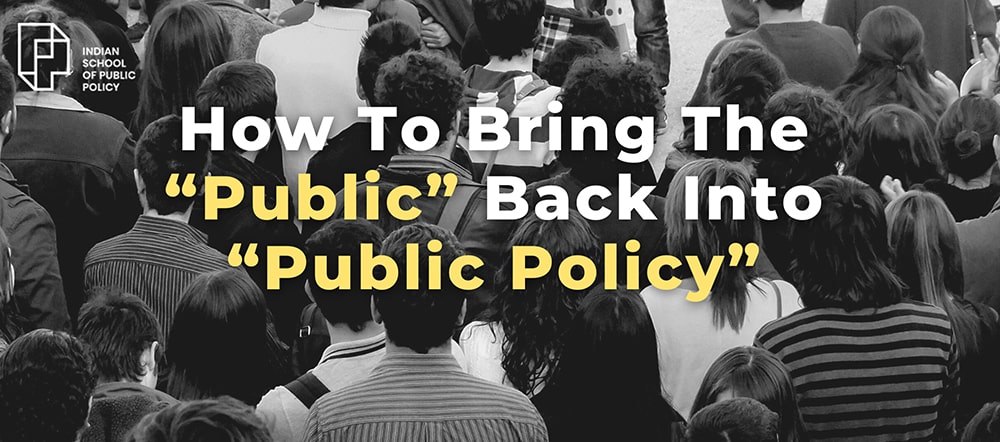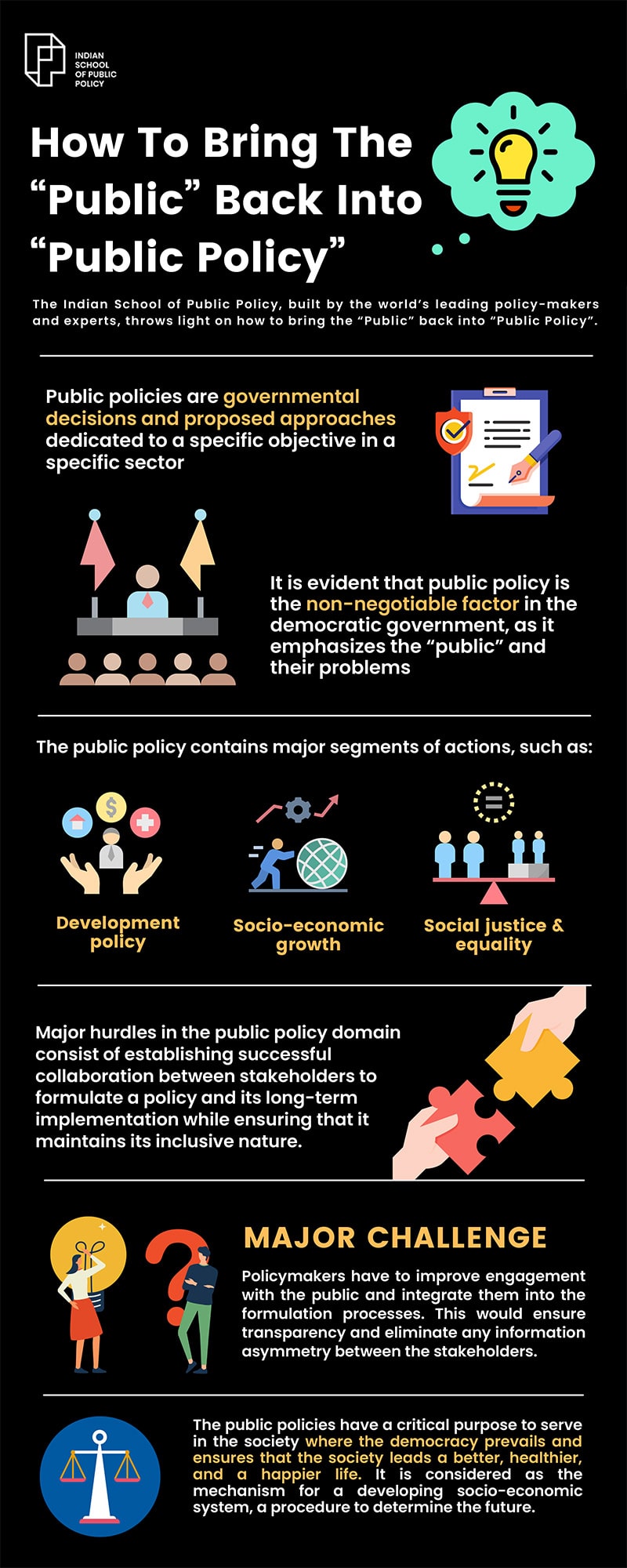
How To Bring The “Public” Back Into “Public Policy”

What Is Public Policy?
We often use terms such as “public interest”, “public sector”, “public opinion” etc. However, first, it is important to understand the very concept of ‘public’ for a discussion in public policy. The public sector comprises human activity, which requires governmental intervention or joint action. The term “policy” as explained by David Easton,a Canadian-born American political scientist, is the “output” of the “public policy”, and the political system is “the authoritative allocation of values for the whole society”.
Public policies are governmental decisions and proposed courses of action dedicated to a specific objective in a specific sector. The focus of political science currently, is shifting to public policy, analysis, and explanation of the causes and consequences of governmental activities. For political scientists, the study of public policy should be directed towards ensuring that the governments acquire appropriate policies to attain transformative changes and achieve the desired social goals, accepting that disagreement will exist in society on what can/ should be considered as the appropriate methods of promoting public good at a given point of time.
It is evident that the public policy is the non-negotiable factor in the democratic government, as it emphasizes on the “public” and their problems, in fact it is a discipline branded as public. The concept of public policy infers the existence of an area that is completely individual, but said in public. Likewise, the public policies have a critical purposes to serve in the society where the democracy is prevails. Its role is to ensure that the society leads a better, healthier, and a happier life, and to maintain the efficient delivery of the goods and services. It is considered as the mechanism for a developing socio-economic system, a procedure to determine the future.
Summary
Public policies are governmental decisions and proposed courses of action dedicated to a specific objective in a specific sector.
Register your Interest to Study at ISPP
Nature Of Public Policy
Public Policy comprises a set of intentions, objectives, means for the attainment of intentions, a description of governmental/ non-governmental units indicated with the accountability of transporting out the intentions, and distribution of resources for the necessary tasks. To recognize a public policy, it is very much needed to examine nature. A policy may contain specific or general, broad or narrow, simple or complex, public or private written or unwritten explicit or implicit, discretionary or detailed, and quantitative or qualitative.
The public policy contains major segments of actions, such as development policy, socio-economic growth, economic growth, equality, social justice, and other similar policies that may be accepted by national policy.
The accountability of public managers and political officials is a positive public value. It is a multidimensional concept – the ones who study it, need to flesh out who is accountable for what, to whom, through what processes, with what kind of standards, and with what possible consequences. Viewing accountability as a social mechanism of relational and communicative nature is helpful for analytical purposes, since it connects individuals and collective policy actors, to accountability “forums” in deliberative processes, that are generally under the threat of sanctions by the forums, in case of unsatisfactory performance, or misconduct of the policy actors. Even if the forums’ monitoring of actors is associated with their actions, and if the rule-makers anticipate the accountability phase, accountability fundamentally occurs ex-post.
Summary
The public policy contains major segments of actions, such as development policy, socio-economic growth, economic growth, equality, social justice, and other similar policies that may be accepted by national policy.
Shortcomings Outlined
The reality/ shortcomings of the public policy in India have been outlined in this section
- Excessive Fragmentation In Thinking And Action – One of the main issues with policy-making in India, is the extreme fragmentation in the structure. For instance, the transport sector is dealt with by five ministries/departments in the government of India, whereas in the US and UK it is a part of a single department. Such fragmentation fails to acknowledge that actions taken in one sector have dire consequences on the others and may even work at cross purposes with the policies of the other sectors.
- Overlapping Between Policy Making And Implementation – Another problem is the excessive overlapping between program formulation, policy-making, and implementation that creates a tendency to focus on operational convenience instead of the public needs. The problem partly is over-centralization – a high concentration of implementation powers at the senior levels of the Ministries. It is also due to the officers being at more ease with the implementation matters than with policy making. The result of which is sub-optimal policies, where inadequate attention to the citizens’ needs, while designing the public policies tends to emerge.
- Lack Of Non-Governmental Inputs And Informed Debate – Public policy is often designed without adequate input from outside government, and inadequate debate on the issues involved. The expertise in numerous sectors lies outside the Government and yet there is no systematic means for obtaining the external inputs, for involving the ones affected by policies, their impacts on different groups, and for debating alternatives. The only example of an organized consultation of the external expertise in India is while formulating the Central Budget, where there is a pre-budget confabulation with the chosen members of the industry, labor, and academia.
Summary
The realities/ shortcomings of public policy in India have been outlined in this section.
Register your Interest to Study at ISPP
Reforming The Structure & Policy-Making Processes To Make It “Public Centric”
This section talks about the reforms in institutional structures and processes that are required to design a holistic and hence, a “public-centric” policy. The proposed measures are in three broad areas.
- Reduction In Fragmentation – The first reform would be to witness a gradual decrease in fragmentation as one climbs the hierarchy. This would mean fewer secretaries who would handle multiple sectors. This would result in the coordination and integration being achieved far more smoothly.
- Disaffiliating Policy-Making, From Implementation, And Decentralizing Implementation Authority – The proposed reform of implementing responsibilities should be handed over to the Boards and Agencies, headed by a Director-General, in the rank of Joint or Additional Secretary. While their primary responsibility would be the implementation, they would also provide critical inputs for policy making. This way they would be acting as a bridge between the policy and implementation.The Secretary will be responsible solely for policy-making and will have no responsibilities for implementation. Their responsibilities would entail getting feedback regarding the progress of implementation to aid the future policies and also to rectify the existing ones. However, there do exist pitfalls in completely isolating the Secretary from the implementation. The policy-relevant ideas and the flow of information could be weakened if the policy-maker is not also the implementer. The lack of authority over current implementation can also lead to a perception of reduced “power” with a downgrading of the importance of the policy-making activity. The way around this is that the Director-General’s annual performance appraisal is carried out by the Secretary. This arrangement would ensure that the Secretary continues to have full access to information and that the policy-making role is not considered secondary or unimportant.
- Improving Integration And The Flow Of Knowledge From Outside Government – The third broad reform would be to create a framework that ensures the availability of subject matter expertise, and non-governmental inputs to the policy-makers. Each department or ministry should have a “Policy Advisory Group” that consists of –
- Top civil servants, covering related sectors – Ensuring that the groups do not become a bureaucratic mechanism without clout, hence, only Secretary-level officers should have access to these groups.
- Industry representatives/ Stakeholders
- Academics, with proficiency in field 48. These Policy Advisory Groups should transcend departmental viewpoints, and offer integrated policy suggestions. Consultation of the Policy Advisory Group, along with the Group’s views should be mandatory on all policy matters before the proposal is placed before the Cabinet.
Summary
This section talks about the reforms in institutional structures, and the processes that are required to design a holistic and hence, a “public-centric” policy.
Also Read – Why Study Public Policy?
Sharpening The Skills Of Policy-Making Manpower
The key reforms that would improve the policy-making competence of India’s civil servants, and sharpen the competence of specialists in Government – would unarguably be a well-designed career path that provides strong incentives for the progressive acquisition of expertise, and professional skills. Experience gained in foreign countries, including in developing ones, has proven to be a significant contributor to good policymaking. The key requirement is of a career path that –
- creates incentives to learn, acquire, and apply the right skills.
- Establishes links between academia and the administration
- identifies and weeds out the underperformers
- ensures that only the ones with the requisite knowledge and intelligence make it to the top policy levels.
Incubated by the country’s leading public policy think tank – Centre for Civil Society (CCS) in 2019, the Indian School of Public Policy was built by the world’s leading policy-makers, influencers, and experts. CCS has nurtured young leaders for over two decades, to think, critically question, and comprehend the principles of a sound policy bringing its focus back to the public. ISPP aims to transform the art of policymaking by inspiring young minds to advance social change. Our founders envisioned institutionalising these initiatives in the form of a cutting-edge institution that can cater to a broader community in the country.
The school begins with a year-long, Postgraduate Programme in Public Policy, Design & Management, to prepare the students for challenging careers in public policy activities across government, industry, and civil society.
Summary
The key reforms that would improve the policy-making competence of India’s civil servants, would unarguably be a well-designed career path that provides strong incentives for the progressive acquisition of expertise, and professional skills.
FAQs
Public policies are governmental decisions and proposed courses of action dedicated to a specific objective in a specific sector. The study of public policy is directed towards ensuring that the governments acquire appropriate policies to attain transformative changes and achieve the desired social goals, accepting that disagreement will exist in society on what can/ should be considered as the appropriate methods of promoting public good at a given point of time.
To recognize a public policy, it is very much needed to examine nature. A policy may contain specific or general, broad or narrow, simple or complex, public or private written or unwritten explicit or implicit, discretionary or detailed, and quantitative or qualitative.
The public policy contains major segments of actions, such as development policy, socio-economic growth, economic growth, equality, social justice, and other similar policies that may be accepted by national policy.
The shortcomings of the public policy in India are as follows –
- Excessive fragmentation in thinking and action
- Overlapping between policy-making and implementation
- Lack of non-governmental inputs and informed debate
Reforms that would improve the policy-making competence of India’s civil servants, and sharpen the competence of specialists in Government – would unarguably be a well-designed career path that provides strong incentives for the progressive acquisition of expertise, and professional skills. The Indian School of Public Policy begins with a year-long, Postgraduate Programme in Public Policy, Design & Management, to prepare the students for challenging careers in public policy activities across government, industry, and civil society.
Check Infographics



